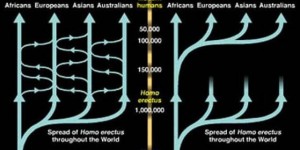Introduction
When museums transform the dead into exhibitions, how do they choose to represent them? In some cases, the dead are anonymous - evidence of a burial culture rather than an individual (see figure 12). In others, the information gathered from a burial or deposition is used to create a detailed reconstruction of the individual concerned. In 2014, the British Museum held an exhibition named ‘Ancient Lives; New Discoveries,’ focused on scientific advancements allowing archaeologists to further explore the lives of mummified individuals from ancient Egypt. In the accompanying book, Taylor and Antoine (2014, 7) write that these advancements allow the modern viewer to ‘draw closer to these long dead individuals and to recognise them as fellow human beings.’ This exhibition raises questions regarding what information can realistically be interpreted about the lives (and deaths) of individuals from their remains, and how museums approach the lives of the people who have become their exhibits.
This report explores how Danish museums portray the dead, and the extent to which we can recreate the lives of individuals, using funerary sources. Information for this report was gathered mainly from museums and supplemented with additional research. A range of methods of recreating the lives of past people are explored; focusing on isotopic analysis, determination of cause of death, identification of chronic illness, determination of sex and age, reconstructions of clothing, facial reconstructions, and romanticisation in the exhibits.
Stable Isotope Analysis
Stable isotope analysis is a relatively new discipline used to gather information about past lives. Isotopic ratios of strontium vary based on geology and oxygen ratios vary based on climate and rainfall (Mays 201, 265). Both are absorbed into human tissue via food and water, meaning isotopic ratios of strontium and oxygen can be used to estimate the geographical regions an individual occupied at different stages in their life (Mays 2010, 265). Generally, archaeologists use dental enamel to gather information on where an individual spent their childhood - if the local isotopic ratios of strontium and oxygen do not match those of the dental enamel, it is likely that the individual spent their childhood elsewhere (Mays 2010, 288). It is also possible to establish whether an individual traveled in the period preceding their death, through analysis of hair and fingernails, if these are present (Frei et al. 2015, 4). Limited preservation of both hard and soft tissue of the same individual means that it is rarely possible to trace their movements in detail. However, some cases lend themselves well to this form of analysis.
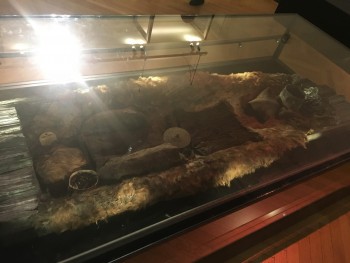
The remains of the Egtved girl, a Bronze Age individual with well preserved hair and other tissues, are on display in the National Museum of Denmark in Copenhagen (see Figure 1). There are two captions above her coffin, illustrating the finds of ‘new research,’ undertaken by Karin Margarita Frei and her team as part of a project tracing the movements of Bronze Age women (Frei et al. 2015). Isotopic analysis of the Egtved girl’s first molar enamel revealed she did not grow up in the region where she was buried (Frei et al. 2015, 5). The museum display posits that her childhood home may have been the Black Forest in Germany, 800 kilometres from Egtved, Denmark (Frei et al. 2015, 5). Analysis of her hair and nails suggests that she lived in Denmark until about a year before death and, in the final year of her life, she appears to have travelled to her childhood home twice before returning to Denmark where she died (Frei et al. 2015, 4).
Further isotopic research is presented in Danish museums, for example the analysis of a tooth from the Haraldskær woman has revealed that she was probably born in northern Jutland, and hair analysis suggests that she lived near Haraldskær for some time before her death (Mosens Kraft 2018). According to information on Iron Age bog bodies, presented by Museum Silkeborg (Tollund Man and Elling Woman, 2018), further strontium analysis of the Haraldskær woman’s hair revealed she had travelled to Germany or Scotland shortly before death.
Stable isotope analysis can also establish the diets of past communities and individuals. Stable isotope ratios of carbon and nitrogen vary in different kinds of foodstuffs, and these isotopic variations are absorbed into the tissues of the consumer (Mays 2010, 265). Frei et al’s. (2015, 4) isotopic analysis of the Egtved girl revealed a terrestrial diet, and microscopic observations of her hair suggest that she may have experienced periods of significantly reduced dietary protein.
Cause of Death
Cause of death can be difficult to determine, as most injuries do not leave observable marks on the skeleton, and remains often show no evidence of lethal injury, as most deaths result from illness or natural causes (Mays 2010, 236). In some cases, the cause of death is obvious. For example, the Vedbæk woman (see figure 2) appears to have suffered a heavy blow to the head, identifiable by the damage to her skull (Danish Prehistory, 2018). It is apparent that this wound began to heal, indicating she lived with this injury for some time (Nielsen 2016, 30). Cause of death may be easier to establish in cases where other tissues are preserved, for example in the cases of bog bodies and other mummies. The rope tied around the Tollund man’s neck is widely accepted to have killed him, evidenced by marks still present on his neck and the swollen tongue revealed by CT scans (see figure 3), and the lack of cervical spine damage shows he was not dropped from a height, shedding further light on the manner of death (Fischer 2012, 46;108; Tollund Man and Elling Woman, 2018). Conversely, the death of the Haraldskær woman (figure 4), another Danish bog body, is a subject of some controversy. While some sources, including Kulturemuseet Spinderihallerne (Mosens Kraft, 2018), advertise strangulation as her cause of death, there is some speculation as to whether she was buried alive, as pegs were used to pin her body down (Parker Pearson 1986, 18; Sanders 2009, 91).
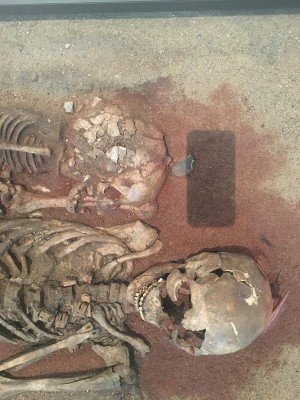
(Photograph: M. Schlanker 2018)
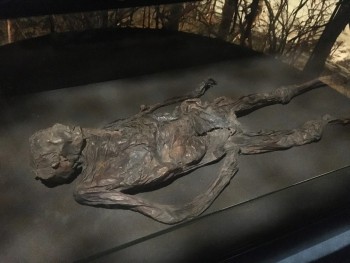
Chronic Illness
In the case of some chronic illnesses, identifiable marks are left on the skeleton. One such disease is osteoarthritis; one of the two most common joint diseases observed in archaeological remains (Mays 2010, 186). Investigation of the skeleton of the elderly man from Borum Eshøj (figure 5) showed he experienced a severe case of arthritis (Nielsen 2016, 96). While it is more complex to observe the skeletal remains of bodies where other tissues are preserved, medical imaging has also revealed evidence of osteoarthritis in the Haraldskær woman’s thumb. Kulturemuseet Spinderihallerne (Mosens Kraft, 2018) presents this information alongside her body. Is this an attempt to astound the visitor with the level of detail that can be interpreted, or is it intended to encourage a connection between the visitors and the exhibit? As Simon Mays (2010, 198) points out: ‘when examining a carious tooth or an arthritic bone we are able to empathise, and indeed sympathise, with the pain and discomfort the individual must have endured.’
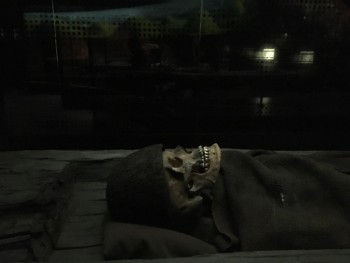
(Photograph: M. Schlanker 2018)
Aging and Sexing
A variety of techniques may be employed to determine the biological age of an individual from their skeletal remains, including observation of the pubic symphyseal morphology, and dental wear analysis (Mays 2010, 61-76). Mature skeletons are more difficult to accurately age, due to rate variations of aging and degeneration (Mays 2010, 59). Pubic symphysis analysis results in widely estimated age ranges which overlap significantly with one another, and studies into aging techniques on mature remains have shown to have a low degrees of accuracy (Brooks and Suchey 1990, 233 Mays 2010, 68-70).
Immature remains can be aged with a greater accuracy. As some aspects of growth and development are influenced by disease and malnutrition, dental development - which is less affected by these factors - is the most commonly used method for aging juvenile skeletal remains and has a high degree of accuracy (Mays 2010, 52-54). In cases where aging using dentition is not possible , observation of epiphyseal bone fusion is used, although this method is more subject to extraneous variables and less reliable for determining age (Mays 2010, 55-56).
The sexing of mature skeletal remains has a high degree of accuracy when both the skull and the pelvis are present (Meindl et al. 1985; Henderson 1989, 79). However, as sexual dimorphism in skeletons results from hormonal differences, it is more difficult to determine sex from prepubescent remains (Mays 2010, 48). The sex of prepubescent skeletons can be determined using teeth, which tend to show some elements of dimorphism, but this is much less reliable than methods used for adult skeletons (Mays 2010, 48; Henderson 1989, 77).
In the case of the Vedbæck child, sex was determined using another method. The child was buried with two flint knives, in an arrangement typical of adult male burials from this period, leading to the interpretation that the child was male (Danish Prehistory, 2018; Nielsen 2016, 30). Sexing individuals based on grave goods is problematic, and there is debate as to which grave goods can be reliably used as gender indicators (Wicker 2012, 248). Bearing in mind the cultural and social nature of gender and the biological nature of sex, Henderson (1989, 81-82) urges caution when using grave goods to sex a burial. Museums appear to utilise aging and sexing to build detailed recreations of individuals and their lives, regardless of potential inaccuracies.
Clothing
Since the 1950s, archaeologists have been involved in recreating the clothing of individuals found in Danish Bronze Age graves, including the Egtved girl and the family from Borum Eshøj (Bröndsted 1950). These costumes remain the subject of a substantial display at the National Museum of Denmark (Danish Prehistory, 2018). The Egtved girl, in particular, has received a lot of attention for her costume: a corded skirt that was new to archaeologists excavating her burial in 1920 (Bröndsted 1950, 17). A replica of the Egtved girl’s costume is displayed in the National Museum, and an information board at Sagnlandet Lejre posits that this skirt may indicate she was a priestess (The Dancing Laberynth, 2018). Her disk-shaped belt plate, despite being common in female burials of this period, has also been interpreted as an indicator of priestesshood (Frei et al. 2015, 3).
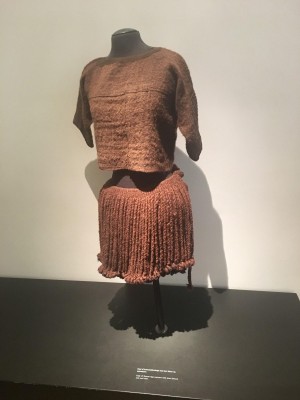
Facial Reconstructions
Almost inarguably more compelling than being presented with a long dead individual’s clothing is being presented with their face. Karin Sanders (2009, 197) points out, ‘the face is at the very core of our understanding of “identity”, “personhood”, “personality” and, not least, our “humanity.”’ Museum Silkeborg’s interactive display (Tollund Man and Elling Woman, 2018) presents visitors with a blinking digital reconstruction of the Tollund man (see figure 7). Facial reconstructions are considered by many to be an important part of recreating the past, and Prag and Neave (1997, 219) even argue: ‘if there is any value at all in the study of history and of one’s past, then the reconstructions should be seen as an important element in completing the story.’
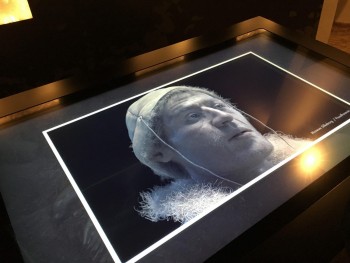
Facial reconstruction has been eagerly adopted by Moesgaard Museum, who feature several reconstructions in their collection (People of the Sun: 1700-500 BCE, 2018; Go on Voyage with the Vikings: AD 800-1066, 2018; The First Immigrants - Stone Age exhibition, 2018). These figures are incredibly realistic, perhaps unsettlingly so, as Prag and Neave (1997, 223) point out is often the case with such lifelike models. The family from Borum Eshøj (figure 9) are presented in a scene portraying the old man’s death, and the Tybrind girl (figure 8) is shown collecting oysters for her dinner. These are dynamic portraits of individuals from the past and, crucially, they do not look particularly different from the museum’s many guests. The museum establishes that these reconstructions cannot be one hundred percent accurate, but the effect of these lifelike, lifesize figurines, gives the impression that the visitor is coming ‘face to face’ with the past.
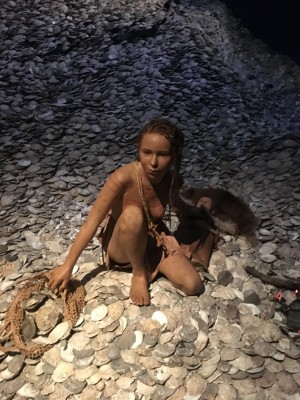
(Photograph: M. Schlanker 2018)
Reconstructions allow visitors to form a more personal connection with museum exhibits and the people they represent. This can provoke empathy, even through thousands of years of human history. The Tybrind girl died aged between the ages of 14 and 16. Despite her death occurring in the Stone Age, the curators create a sense of mourning around her, and the young baby buried with her. Denmark has one of the lowest infant mortality rates in Europe, and such young deaths would be particularly shocking, but not unimaginable, to a local audience. The caption underneath her skeleton reads: ‘she is still a child [...] Loss and hardship are part of daily life in a time of short life expectancy and high child mortality’ (MacDorman et al. 2014; The First Immigrants, 2018). A similar sense of tragedy is also seen in the information regarding the Vedbæk child which reads: ‘amulet beads [...] failed to protect him, and his death shattered the family’s hopes for a great new hunter’ (Danish Prehistory 2018). Their young age becomes part of the tragic story of lives lost too soon, which may reflect modern Western attitudes to death. As Sayer writes (2010, 483): ‘the idea that the young can be cheated of life by death suggests that they were owed a life course.’
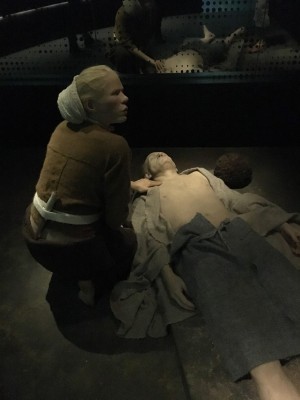
Moesgaard Museum, Aarhus
(Photograph: M. Schlanker 2018)
Romanticism and Mistaken Identity
There is a clear element of romanticisation in the way the information about the Tybrind girl and the Vedbæk child is portrayed by their respective museums. Romanticisation also played a major part in the mistaken identity of the Haraldskær woman (figure 10). On first discovery, the Haraldskær woman was believed to be Queen Gunhild, a Norwegian queen supposedly drowned in a bog around 970 CE (Sanders 2009, 92). More recent investigation revealed that the body dated much earlier to the Iron Age (Mosens Kraft, 2018). However, Sanders (2009, 94) argues that without the dramatisation of the Haraldskær woman’s life, she would have been disregarded. We may owe her continued preservation to her embellished history.
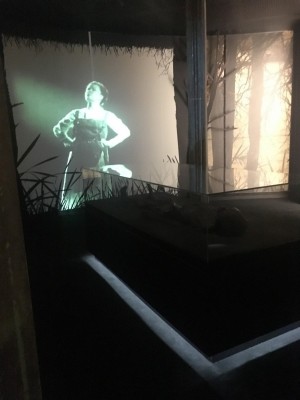
(Photograph: M. Schlanker 2018)
Moesgaard: A Voyage with the Vikings
Moesgaard Museum cultivates a personal relationship between one of their exhibits and the visitor in a memorable way. Their Viking exhibit (800-1066 CE)allows visitors to follow the stories of eight inhabitants of Viking Aarhus. Most of these individuals are entirely fictional, however one is particularly notable in the context of this report. The Randlev woman (figure 11), who expresses distress over her husband’s long voyages and her own tooth loss, is heavily implied to be the skeleton on display of the same name. By following the Randlev woman’s story, visitors see her as a person with distasteful views. For example, her frequent advocacy of slavery. She also displays more relatable aspects, as a middle aged woman concerned about losing the respect of her community as she ages, and also helps visitors to better understand the role of women in Viking society (Go on a Voyage with the Vikings: AD 600-1066, 2018). While a great deal of the Randlev woman’s story is fabricated, it remains a memorable way of presenting the dead and engaging with the past.
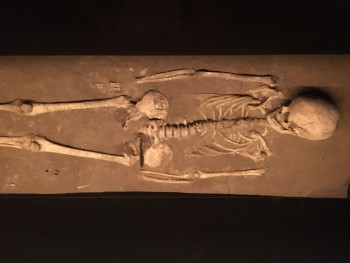
(Photograph: M. Schlanker)
The Anonymous Dead
It is worth mentioning that not all human remains exhibited by museums are allowed such elaborate personalities, nor are they scientifically examined or presented alongside research material. The anonymous dead, displayed as exhibits rather than people, made up a significant portion of the museum exhibits investigated, despite controversy in other European countries regarding the ethics of display (See figure 12; Sayer 2010 482-485). According to Jones and Whitaker (2013, 652), prehistoric remains in particular are often considered as ‘anatomical objects rather than the remains of people-now-dead,’ and this anonymity serves to ‘protect both the corpses and the onlookers’. Along this line of thinking, Prag and Neave (1997, 219) ask: ‘is the making of a reconstruction a prying into a person’s private life, almost a form of voyeurism?’ There is an idea that reconstructing the past lives and presenting these reconstructions could, in fact, be negative. However, Sayer (2010, 488) argues ‘the public do not need to be protected from the ancient dead,’ and that the display of human remains allows museum patrons to better understand the past.
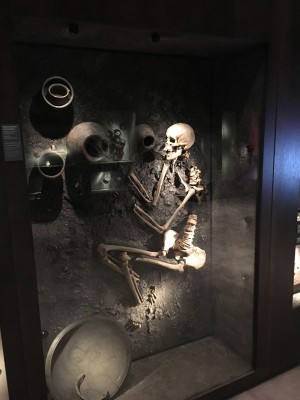
Conclusion
A variety of techniques can be used to interpret information from an individual’s burial or deposition. These techniques are utilised by Danish museums to recreate the stories of past people. Using various methods, we can better understand individual mobility and analyse an individual’s diet in various ways. Forensic-style analysis can reveal cause of death, but only in cases where damage is left on preserved remains. Damage can also be seen on remains through chronic illness, such as arthritis, which may be included in museum displays in order to create empathy for the individual on display. Techniques used to sex remains and estimate age are commonly utilised by museums, despite the difficulties in accurately determining age in mature remains or sex in prepubescent remains.
While much can be interpreted or estimated using these methods, we cannot comprehensively determine an individual’s story from their remains. Institutions such as the National Museum of Denmark and Moesgaard Museum utilise facial reconstruction and reconstructions of clothing to encourage a more personal connection between visitor and exhibit. Both of these museums also attempt to create sympathy for their exhibits, and museums may embellish information to form a connection between the visitor and the exhibit. Despite this, not all remains are treated equally, and many of the dead presented in Danish museums remain anonymous and lack narrative. Ethical concerns have been raised regarding the display of human remains, and opinions are divided on which path is best to take. However, there is value in the display of human remains and particularly in reconstructing the lives of past individuals, demonstrated by the effect that this has on visitors and their relationship to the past.


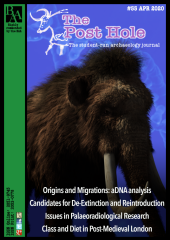

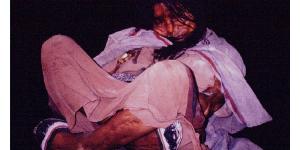
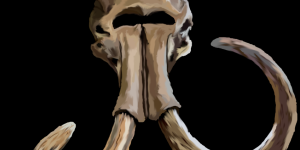
![Figure 1: Map of cemeteries studied in this essay. Porter, C, "Map of Cemeteries Used" [JPG map], Scale 1:100000, GB Overview [ geospatial data], Updated: 2019, Ordnance Survey (GB), Using: EDINA Digimap Ordnance Survey Service, <http://digimap.edina.ac.uk/>, Created: October 2019.](https://www.theposthole.org/sites/theposthole.org/files/styles/article_thumb/public/articles/454/fig%202.png?itok=cGHEw2KW)
